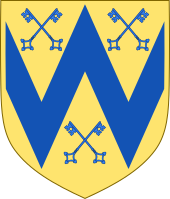 | ||||||||||||
| Motto | Innovation and Opportunity[1] | |||||||||||
|---|---|---|---|---|---|---|---|---|---|---|---|---|
| Type | Public | |||||||||||
| Established | 1827 - Wolverhampton Tradesmen's and Mechanics' Institute 1926 - Wolverhampton and Staffordshire Technical College 1950 - Wolverhampton College of Art 1951 - Wolverhampton and Staffordshire College of Technology 1988 - Wolverhampton Polytechnic 1992 - university status | |||||||||||
| Endowment | £77,000 (2021)[2] | |||||||||||
| Budget | £181.5 million (2020-21)[2] | |||||||||||
| Chancellor | Lord Paul | |||||||||||
| Vice-Chancellor | John Raftery (Interim) | |||||||||||
| Students | 20,200 (2022/23)[3] | |||||||||||
| Undergraduates | 13,440 (2022/23)[3] | |||||||||||
| Postgraduates | 6,760 (2022/23)[3] | |||||||||||
| Location | , England | |||||||||||
| Colours | ||||||||||||
| Affiliations | Million+ Universities UK | |||||||||||
| Website | wlv | |||||||||||
The University of Wolverhampton is a public university in Wolverhampton, England, located on four campuses across the West Midlands, Shropshire and Staffordshire. Originally founded in 1827 as the Wolverhampton Tradesmen's and Mechanics' Institute, the university was subject to a series of merges, incorporations, and expansions with other local colleges, one of which occurred under the supervision of Prince George, Duke of Kent.
The university has four faculties comprising eighteen schools and institutes. It has 18,875 students and currently offers over 380 undergraduate and postgraduate courses.[4] The city campus is located in Wolverhampton city centre, with a secondary campuses at Springfield, Walsall, and Telford. There is an additional fifth campus in Wolverhampton at the University of Wolverhampton Science Park.
- ^ "Our Crest". University of Wolverhampton. Retrieved 15 January 2010.
- ^ a b "Financial Statements and Annual Review for the year ended 31 July 2021" (PDF). University of Wolverhampton. Retrieved 13 February 2023.
- ^ a b c "Where do HE students study?". Higher Education Statistics Agency. Retrieved 23 September 2024.
- ^ "Courses". University of Wolverhampton. Retrieved 10 February 2010.